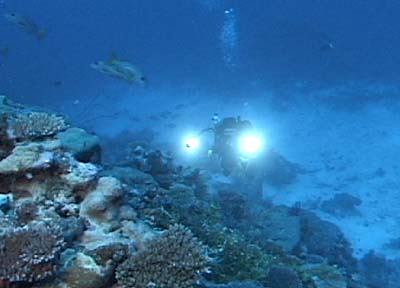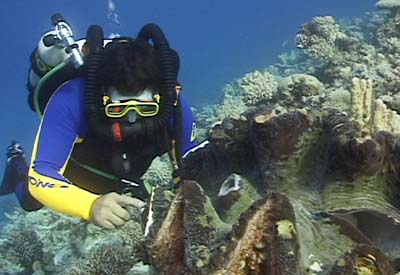
|
Journal Entry July 29, 2000 Jonathan Bird - Director of Photography |
Today we decided that we needed to take a break from diving all the wrecks and film the incredible variety of marine life found around the atoll. Those who know me also know that you just can't keep me away from sharks that happen to be in the area, and I had been itching to get over to Speedball (a dive site on the ocean-side of the island of Roi) ever since we arrived.
 |
View of Roi from Speedball dive site - flat seas - flat island. |
In 1995 I spent 5 weeks working at Speedball on a film about sharks. The film featured about 20 minutes on Gray Reef sharks. For some reason, there are a ton of sharks that naturally hang out at speedball nearly all the time. The dive site is a steep wall (but not vertical) which drops down to 150 feet where there is a sandy flat spot, like a shelf. On the outside of the shelf, the wall continues forever into the blue. The sharks circle around the sand. The visibility at Speedball is often incredible. Sometimes, you can see the sand quite well from the surface.
We arrived and got into the water. We didn't need any helmets or funky lights. This was going to be an easy, fun dive to play with the sharks, assuming they would cooperate. The visibility was perfect, and we could see the sand below as soon as we rolled off the boat. As I dove down towards the sand, I began seeing the shapes of many fish swirling about down below. Once I reached 30 feet, I realized that they weren't ordinary fish. That was a school of over 50 gray reef sharks--and they were working their way up towards me!
I situated myself at a nice comfortable depth of about 40 feet. We had all rigged the rebreathers with the 60% orifice and mixed up 50% nitrox for the supply gas. With that arrangement, we had a nice, low-bubble configuration good for shallow diving (no deeper than 50 feet to be safe). I was curious what the sharks would do with the rebreathers. Would they approach, unafraid of us because we lacked noisy bubbles? Would they get too aggressive because we lacked bubbles to keep them frightened? Would they ignore us because we weren't as interesting as something making bubbles? We would soon find out. We had assigned "safety divers" to each of the photographers just in case the sharks got a little spunky. The problem with shooting sharks is that when you keep your eye glued to the viewfinder to keep a shark in the frame, another shark sneaks up behind you. More often than not, the shark behind you just swims by and you never even know it's there. Sometimes it bumps you and scares the hell out of you. Usually nothing comes of it, but, it never hurts to be safe
 |
A grey reef shark that's ascended from the sand chute at 150 feet to join us on the shallow reef. |
Mark acted as my safety diver, while Tim Gernold (our pal from Roi) acted as Gator's safety diver. In the event of incredible shark action, we had Tom on camera #3 and Cliff was his safety diver. Each of the safety divers had a little rod--whatever we could scrounge up--to push the sharks off if they got aggressive. It seemed like a good idea, even though we hardly expected to need them.
Once the sharks saw us all, they came up the wall to investigate. Not all of them, but about six. They made a few passes and swam off. We got a few nice close shots, but for the most part, I think the rebreathers actually diminished our ability to shoot them. They seem a bit more curious when the divers are all wearing open-circuit scuba gear.
Gator had brought a cool little homemade rattler, consisting of a couple large metal ball-bearings in a short length of household copper pipe with end caps soldered on. When he shook this thing, it made a loud clanking which is great for signaling a dive buddy and for attracting sharks. The clicking brought them around again briefly, but then they went back down deep and stayed there. So much for the man-eaters!
| Gator coming up the wall from the sand chute with bright lights illuminating the way |  |
We spent the rest of the dive playing with the anemonefish found perched in their anemones all over the place while our safety divers engaged in underwater fencing matches with their shark poles. They had faced the sharks gallantly.
Gator films anemonefish using daylight balanced HID lighting |
 |
After all the excitement, we got back on the boat and had lunch while we debated where we would spend our second dive. I had hoped for a bit more shark action, and planned two dives at Speedball. Mark wanted to go find some planes, but they are all deep and our tanks were mixed with 50% nitrox, limiting our depth.
Suddenly Cliff spoke up. "I want some clams!" We all looked over at him, heads crooked with blank stares. What the.......?
"I came all the way to the Pacific and I want to see a giant clam!! Where are the giant clams around this place?" We knew they were around, but nobody was quite sure where. We got on the radio and called Tim, who was now back to his boat, Boogieman.
"Boogieman, Boogieman, this is Spare Time. Where do we find some clams around this place?" Tim immediately knew exactly what we were talking about.
"No problem, go around behind Sand Island. They're all over the place. Follow me, I'll show you." So, we pulled the anchor and off we went to Sand Island. Sand Island is just the kind of place you might expect with a name like Sand Island.
It's a sand bar about 100 feet long with nary a single living organism on it. The thing looks like a sand trap in the middle of the largest water hazard in the history of golf. It would make a great golf commercial. If someone planted a single coconut tree on it, you would have the quintessential desert island for a Far Side cartoon.
| View of Sand Island from the Dash-7 Commuter plane - The island's reef occupies more space than the island itself - just the way we like it! |  |
We pulled into about 30 feet of water and dropped anchors in a sand patch to avoid harming the coral. We paired off in teams and set out to find clams. We didn't have to go far. Cliff and I teamed up and headed east. We kept finding medium sized clams, under 2 feet wide. But Cliff wasn't satisfied. He kept swimming. After we had been swimming in one direction for about 45 minutes, and had probably gone 50% of the way around the island, we came upon a nice big clam. Before Cliff got it too agitated, I wanted to get a nice shot of him swimming up to it. I positioned myself near the clam and motioned for him to back up, then swim up to the clam and look at it. With perfect buoyancy control, Cliff backed up, paused, then swam forward and right up to the clam. Then, he gently placed his fingers near the edge of the clam's mantle to feel the soft skin with all the colors in it. Right then, the clam violently snapped at Cliff, who jumped about a foot and jerked his hand back in an instinctive reflex, as if you would blink if someone pretended to punch you in the eye. I just about lost control in a fit of convulsive laughter. My mask leaked and I nearly flooded the whole breathing loop of my rebreather. Cliff is not a small guy, and he was just diving with Gray reef sharks only two hours earlier. Now he is eaten by a clam. The irony!
 |
Cliff, confidence buoyed by surviving dive with sharks tests mettle with killer clam |
We got our shots and began the long swim back to the boat. Back on board, Cliff made a comment about how long we swam and about the fact that we were underwater for nearly two hours on that dive alone, but his legs didn't hurt. He admitted that he was really starting to like those Force Fins. My pal Bob Evans back in California loves to hear it when people say that. I converted another one Bob!!
After three hours of bottom time (on one 50 cubic foot tank to boot!) we were all tired and ready to head back. The sun was getting low in the sky and we still had tomorrow's nitrox to mix. We pulled anchors and headed back to the dock. It all sounds like fun and games, but a filmmaker's life is not always easy. The days are long and the sun is hot. We hate to carry all this gear everywhere and we are much more concerned with water clarity and light levels than most divers, but when we get in the water, we remember why we do it. This is the end of a perfect day of diving in a beautiful place! Another adventure tomorrow.
 |
 |
 |